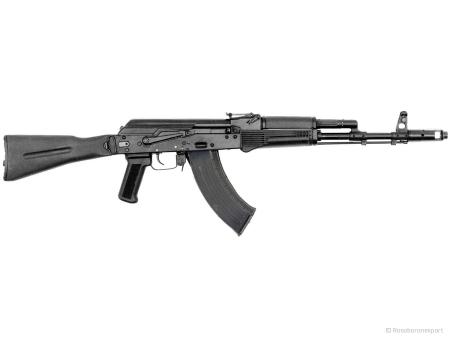About AK 103 And How Is It Different From AK 47
India and Russia have signed an agreement that will make way for indigenous production of assault rifles under the government’s ‘Make in India’ initiative. Indian Army will have an advantage of producing Kalashnikov rifles at home, reducing the dependency to procure from abroad. The plan is to manufacture 6,50,000 Kalashnikov 7.62 mm AK-103 assault rifles which will progressively replace the INSAS and AK-47 rifles currently in operation.
Now that Indian Army is planning to replace INSAS with 6,50,000 Made in India AK 103 we should know about AK 103 and how is it different from the common AK 47.
Short Answer
In short,
Differences in the outward appearance:
-
The AK 103 has plastic furniture while the AK 47 has wooden furniture so weight is reduced.
-
The AK 103 is slightly longer than the AK 47 by virtue of the fact that it has an extended flash suppressor.
Now for the technical & performance differences:
-
The AK 103 features a 3-round burst features a 3 round burst feature between full auto & single shot. This is useful as an AK 47 firing at full auto is an extremely unstable weapon that cannot be efficiently directed towards a target.
-
It has a picatinny rail for mounting lasers, lights, scopes etc.
-
It weighs just 3.4 kg(empty) or 3.6 kg(full) as opposed to the AK 47’s 3.47 kg(empty weight).
The AK-103 assault rifle is a derivative of the AK-74M made for the 7.62×39mm M43 round, similar to the older AKM. The AK-103 can be fitted with a variety of sights, including night vision and telescopic sights, plus a knife-bayonet or a grenade launcher. It uses plastic components where possible instead of wood or metal, with such components being the pistol grip, handguards and stock.
The current issue steel-reinforced matte true black nonreflective surface finished 7.62×39mm 30-round magazines, fabricated from ABS plastic weigh 0.25 kg (0.55 lb) empty. Early steel AK-47 magazines are 9.75 in (248 mm) long, and the later ribbed steel AKM and newer plastic 7.62×39mm magazines are about 1 in (25 mm) shorter.
In India, currently being used by Naval Special Forces, MARCOS. The Russian arms company Izhmash is negotiating issuing a license to an Indian private arms manufacturer to produce the AK-103.
The transition from steel to mainly plastic magazines yielded a significant weight reduction and allow a soldier to carry more rounds for the same weight.
AK 47 vs AK 103
The AK-47 was the original rifle created by Mikhail Kalashnikov in the late 40s. It’s chambered in 7.62x39mm and looks like this:
The AK-103 is based on the AK-74M, a more modern rifle based on the original AK design. It’s also chambered in 7.62x39mm, but has many more modern design features like polymer components and folding stock. It looks like this:
The AK-47 was the original “AK”, they were built with machined receivers, heavier parts and wood furniture. The design was altered for cost & ease of manufacture and changed to a stamped receiver (AKM), the Russians then switched to 5.45 and as a result the AK-47 was discontinued. When the need again arose for 7.62 weapons, they began manufacturing the AK-103 (there are also models 101 through 105 which all sport a redesigned recoil reducing gas system). The original AK-47 was supplied with wood stock & foregrip, heavy gauge steel magazines and had no factory supplied muzzle break or scope mount. Some of the internal parts of the original AK-47 were also of heavier gauge steel. From a purely functional standpoint, there is no significant differences between the AK-47 & the AK-103. …In Kalashnikov Arms published in Moscow (1999) and compiled by Alexie Nedelin, here is how the 100+ numbers run :
Starting with the M receiver,
AK-101 : 5.56 mm, full length barrel, AK-74 muzzle brake, plastic furniture, folding (to the left) buttstock, scope mount attachment on left side of receiver.
AK-102 : Same as above except barrel length cut from 415 mm to 314 mm, front sight integral with gas block, Krinkov muzzle brake.
AK-103 : Same as AK-101 except chambered for 7.62 mm.
AK-104 : Same as AK-102 except chambered for 7.62 mm.
AK-105 : Same as AK-102 except chambered for 5.45 mm.
That’s it, leave a comment if you liked this. Also, send it any questions/suggestions you might have. Jai Hind!
Read my other posts here:
The story behind badluram ka badan
10 facts about the Indian Air Force






 Order Now on Amazon
Order Now on Amazon

A couple notes- it seems somewhat disingenuous to compare the AK103 to the AK47 instead of comparing it to the AKM. The AKM is by and large the model you’ll still find all over the place.
From what I gather, the 103 and 104 were developed not because Russia had a need, but because they knew a lot of other countries still had plentiful supplies of 7.62×39 and would likely be interested in using it with new rifles. Along with the 101 and 102, it sounds like they expected to also use these as a base for commercial exports.
At one point the article says the 101-105 models all have recoil reduction systems, but that’s actually the AK107-109 models. It doesn’t reduce recoil per se, but balances out the effect of the moving parts hitting their forward and rear positions. With the improved muzzle brake, recoil impulse is more controllable.